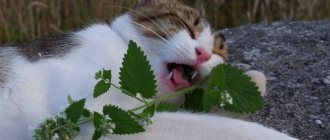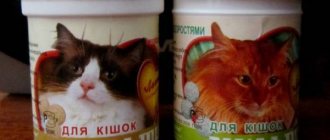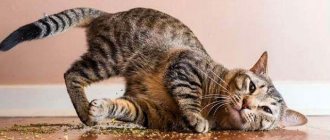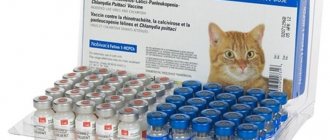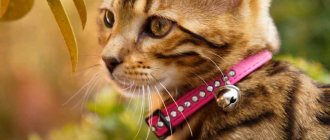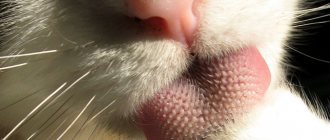People who have cats as beloved pets derive incredible emotional pleasure from interacting with these highly organized, complex creatures with developed sensuality. Pets themselves are also no strangers to emotional outbursts and discharges, which can be caused by contact with their fellow animals, communication with people, as well as…..catnip or catnip.
The article will discuss the main issues related to the possible use of this plant in the life of cats, its effects on them, as well as common features of use.
Photo 1 shows what cats' favorite catnip, often simply called catnip, looks like.
Flowers are the remains of heaven on Earth. Blooming catnip is no exception
Description and properties of the plant
A responsible owner approaches any decision regarding his pet carefully. In this case, we should start by answering the question: catnip - what is this miraculous plant?
So, the so-called catnip is a perennial plant of the Lamiaceae family. Before its cultivation began in Europe, it grew in the countries of North Africa and the Mediterranean. This plant is also known as mint catnip and catnip. For those interested in scientific names, the Latin name for catnip is Népeta catária. The plant has diverse properties:
- tonic
- antipyretic
- anti-inflammatory
- painkillers
- sweatshops
- antitussives
- anthelmintic
- choleretic
It's a pity that there are no mint trees...
Next, you should understand how catnip acts on cats in most cases.
Meaning and application[edit | edit code ]
In Europe and Eastern countries, the plant is used as a spice. Essential oil with a strong lemon smell is used in the production of confectionery, perfumery, and soap making.
Catnip was used in folk medicine internally for bronchitis, anemia, migraine, hysteria, melancholy, cholera, as an anthelmintic, antitussive and appetite-increasing agent; externally - for some skin diseases. The beneficial substances of the plant are also used as diaphoretics and sedatives.
Clinical trials have shown the possibility of using the plant as a bitter for decreased appetite, as an expectorant for bronchitis, and also for heart neuroses. When studying the effect of the plant on the heart of a frog, it was found that an aqueous infusion of its flowers and leaves increases the amplitude of heart contractions by up to 40%, often with an increase in rhythm.
Valuable honey plant, produces a lot of nectar. It is often cultivated in apiary areas.
Effect of mint on cats
The mechanism of action of catnip on cats is interesting. When a cat inhales the essential oils contained in catnip through the nose, this is a signal to the hypothalamus of the brain, which forms an interesting behavioral reaction of the animal. Nepatalactone (the essential oil in mint) is detected by the cat's smell; its effect is comparable to the effect of a mating pheromone on a cat.
Cat brain
Inhaling nepatalactone stimulates some cats to playfulness, while others, on the contrary, relaxes them, the cat concentrates on one point. This condition lasts from 5 to 15 minutes, and only after 2-3 hours is a second reaction possible after a new inhalation. According to veterinary statistics, approximately a third of sexually mature cats experience excitement from inhaling mint essential oils.
Example of a calm cat reaction to nepetalactone
As a rule, cats and cats that have not reached puberty remain indifferent to the effects of catnip on them. Why do they need it?
Not ready for mint!
(the image on the container does not correspond to reality - the product is “addressed” to individuals aged 6-7 months, kittens do not need it)
This is where I belong at my age, and not on your jar...
Why cats love her
The secret why cats love catnip so much and its aroma, while they remain indifferent to others with a similar smell, has long been revealed. Our pets are attracted not by the aromatic smell itself, but by its source - nepetalactone.
This substance affects the neurons of the cat's brain, causing short-term hallucinations and changing the animal's behavior pattern.
It is difficult to predict exactly how a pet will behave under its influence. Different effects are observed. A passive animal can begin to play actively, and a violent one can calm down.
The benefits and harms of mint for cats
Unlike valerian, mint does not cause addiction, nor does it cause seizures, hallucinations and other disorders of the cardiovascular and digestive systems. Catnip is needed, first of all, for
to help correct the cat’s behavior - to accustom it to something, to make travel easier (to relieve stress).
Harm can be caused to the animal; if catnip is eaten, it will cause stomach upset. The smell of peppermint (nepetaloctone) is comparable to the effects of marijuana and LSD, and uses the same biochemical pathways in the brain. As a reflex suppressor, catnip, if used excessively, will thin the cat's nervous system and reduce the animal's reaction.
Cheer your cat up!
It should be noted that there is also a scientific approach to the issue of studying the effect of catnip on the cat’s body. In the early 2000s, this was done in the UK by scientists from the universities of Belfast and Lincoln. They set the task: to study the reactions of cats to various stimuli (the number of animals participating in the experiment was several dozen). For this purpose, cats were offered three different scents - pieces of cotton fabric soaked in the body odor of a domestic rabbit, catnip and lavender. Surprisingly, the smell of rabbit lost out to mint. The most striking cat reaction was caused by the fabric soaked in catnip. The cats did not let go of these scraps of fabric from their paws for a long time and became playful and active. The researchers also noted the fact that the effect produced by the smell weakens over time as cats gradually become accustomed to it. Scientists have come to the conclusion that a constant change of smell is important for pussies to live comfortably, which, in turn, dictates that owners need to take care of providing the animal with a place where the cat can easily breathe fresh air and accumulate olfactory impressions.
When not to use mint
There are situations where mint, despite its benefits, can be harmful. That is why, before giving catnip to your pet, you should familiarize yourself with the list of contraindications for use.
Under no circumstances should you give the herbaceous plant:
- pregnant cats;
- nursing cats.
This category of furry pets is easily overstimulated, so mint can cause serious stress to the cat. Such an emotional state depletes the nervous system. In addition, you should wisely give a sedative herb to your cat when its use is appropriate and will not lead to disruption of the activity and mental state of the tailed cat.
Is catnip safe for animals?
The harmlessness of mint is due only to the cat's temporary dependence on enjoying the smell of the plant. A cat, under no circumstances, will inhale incense for days on end.
Experts recommend giving catnip to animals with a high degree of aggression with caution.
Excessive overexcitation of the nervous system of an already aggressive animal can provoke:
- throwing a cat at other animals;
- aggressive attitude towards children and adults;
- room marks.
Under no circumstances should you offer grass to an animal every day.
Varieties of catnip
There are more than 250 varieties of nepeta. The most common of them:
Catnip (nepeta cataria), reaching a height of more than 1 meter;
Lemon catnip (nepeta cataria var.citriodora);
Catnip grandiflora (nepeta granfiflora);
Catnip semi-sedentary - the most beautiful (nepeta subsessilis);
Nepeta subsessilis: gives pleasure to both eyes and noses….
A person has 5 million nerve endings in their nose, while a cat has about 19 million. Therefore, the common belief that cats have a weak sense of smell is erroneous.
Siberian catnip - (nepeta sibirica), not inferior in beauty to the previous one, but growing worse;
Fassen's catnip (nepeta faassenii) - especially popular in Europe;
Musin's catnip (nepeta mussinii) is a mountain species, including the Transcaucasian catnip - nepeta transcaucasica.
Contraindications
People who have been diagnosed with the following diseases should avoid consuming catnip:
- severe heart disease;
- gastritis with high acidity;
- tachycardia.
You cannot take budra and drugs based on it even in small doses during pregnancy and breastfeeding.
Overdose or too frequent consumption of catnip can lead to increased heart rates and the development of cardiac diseases.
The plant is absolutely safe for cats.
Unless your pet eats too much of this fragrant herb, his intestines may become upset for a short time.
But for cats, catnip is completely safe
Catnip literally delights our cats, but also has many benefits for humans. For our feline friends it is a real "drug", albeit a useful one because it has no harmful effects and is not addictive, but for us it is a mild sedative with a digestive effect.
Botanical name: nepeta cataria, cataria vulgaris, xalamintha albiflora, glechoma xataria, catnip, catnip, cat grass.
Catnip is an herbaceous perennial plant from the mint family that grows from 90 cm to 1.4 m in height. It has straight, green, square-shaped stems with brown-green foliage. The leaves have curly edges (triangular to ovate), with gray-white hairs on the underside. The fragrant flowers are small, white with spots of pale pink or purple, and bloom from late spring to mid-autumn.
There are about 250 species of plants in the Lamiaceae family, known collectively as catnips. Most of them are perennial plants that grow in height from 30 cm to 1 m. The catnip family grows in Europe, Africa and South-West Central Asia, in Russia it is distributed throughout almost the entire European part, in the North Caucasus, in the south of Western Siberia and the Far East, and was also naturalized in North America. Some are grown as ornamental plants that attract birds, bees and butterflies.
Most people associate catnip with its effects on cat behavior. However, if the plants in your garden are not damaged, cats will most likely not be interested in them. But some cats will roll around near the plant, meow, and even eat the plant, after which they fall into a relaxed, sleepy state. The thing is that big cats, such as lions, have inherited a specific gene - nepetalactone, which leads to such a sensitivity to the aroma of catnip. Cats that are younger than six months old and cats that have not carried this gene since birth do not have any reaction to catnip.
Practical purposes of application
Catnip is used to tame a cat to a sleeping place (finely chopped mint is sprinkled on the cat's bed, on a diaper in a cat carrier, etc.), to the toilet, scratching post (a special spray containing essential oils is sprayed onto it). catnip oil). To stimulate physical activity, toys are given that contain catnip (mouse, etc.). In addition, catnip copes well with cat stomach problems and can help restore appetite. It also has bactericidal properties (kills worms).
When the mint season ends...
Growing
Some owners prefer to pamper their pets from time to time. This, they say, allows for better control of the animal and improves its mood. To do this, they grow mint right at home and regularly treat the cat.
If you want to do the same for your four-legged friend, all you need is a potty and a secure place that your cat can't get into. Seeds can be found either in a special store, or ordered online, or collected on the street.
Many people will appreciate the simplicity with which sprouts burst out of the ground and become beautiful flowers.
Don’t worry too much about watering, as the plant is accustomed to overflows and droughts.
How to determine the gender of a kitten - learn to distinguish kittens yourself. Advice from breeders and veterinarians on how to distinguish the sex of kittens (120 photos and videos)How cats see - the structure of the organs of vision, colors and features of cat vision (video + photo)
How to make friends between a cat and a dog - ways and methods of teaching animals to live in the same house (110 photos)
Why doesn't my cat react to catnip?
Between 50 and 75% of cats are affected by catnip. Various reactions to the use of catnip, as well as their complete absence, is a hereditary trait - the cat simply does not have responsive receptors. So, for example, mint has practically no effect on Siamese cats.
Indicative photo: Siamese cats do not react to mint, they are interested in other plants.....
Contraindications
Cats are naturally endowed with the ability to recognize which grass they can take and in what quantity. However, the owner is responsible for the pet. Therefore, you should not rely on the animal’s intuition if:
- the cat is pregnant;
- the pet reacts too violently to the action of catnip. In this case, excessive consumption of grass can deplete the animal's nervous system. A violent reaction should be understood as agitated behavior of the cat for more than half an hour with excessive physical activity.
In these cases, you should limit your pet's access to catnip. There are no other contraindications to taking catnip. But, if there are several cats in one house, and among them there is a male, it must be taken into account that under the influence of the plant he can become aggressive. Therefore, cats can only be given catnip separately from cats.
Where to buy lemon catnip?
Lemon catnip (nepeta cataria var.citriodora) is a branched perennial plant with a pleasant lemon aroma, shaded by the smells of mint and geranium. Its leaves, inflorescences and stems are removed during the period of mass flowering and dried under a canopy.
Catnip is sold in pet stores and veterinary pharmacies, usually in the form of a spray, the volume of which varies from 10 to 150 ml. A spray with a volume of 10 ml has an average price of 40-45 rubles.
A ready-made tincture of catnip in alcohol, which has a wide spectrum of action, can also be purchased at the pharmacy. The use of this “human” version of catnip for “feline” purposes requires consultation with a veterinarian.
Catnip tincture, sold in a pharmacy
Growing catnip at home
Catnip is grown by sowing seeds in a box in late winter or early spring. Cover with film and place in a warm place. The first leaves that appear are transplanted into pots and placed in a cool place so that they do not stretch, then put back in the heat. The plant is planted when 3-4 large leaves appear on it.
Regular, measured watering is required; you can use trays for this. Leaves and shoots are formed by cutting from the sides. It is necessary to use fertilizing in the form of mineral fertilizers.
And they said that you would grow mint for me...
Medicinal uses of catnip
The use of catnip for medicinal purposes is negligible, as over time it has been surpassed by stronger or more effective drugs in modern medicine. However, catnip has been used to treat a variety of health problems, whose active components, including nepetalactone, are similar to the sedative properties of valerian root.
Traditionally, catnip was used at the first sign of colds and flu, to relieve tension from headaches, digestive problems, and to relieve menstrual cramps. There is an assumption that rubbing catnip tincture has a beneficial effect on joint arthrosis. Generally, the herb has a mild calming effect and reduces anxiety.
Catnip also has antiseptic properties that help heal small wounds, cuts, insect bites and other minor skin inflammations.
Native Americans from the Appalachian region used crushed fresh leaves to relieve toothache. The active ingredients are released by steam distillation.
Storing mint
Catnip is not very susceptible to disease. It is collected in the morning, before the flower buds open (to ensure an abundance of essential oils), cutting off the stems and leaves, and washing. The cat is given it both fresh and dried.
A third of the cats on the globe would subscribe to this advertising slogan on the packaging of dried mint.
To dry it, several stems are hung up and the leaves are dried in a bowl.
It is recommended to store mint in a closed jar, in a cool place, away from cats. The description of storage rules should be carefully read when purchasing the product at a veterinary store/pharmacy.
- The following are made from dried mint raw materials:
- Powder
- Spray
- Bubble
- Pressed balls
- Catnip extracts
Veterinarian advice
Since pheromones, sprayed at the right time and in the right place, significantly improve the cat’s emotional status and are able to correct the animal’s unacceptable behavior, veterinarians advise trying the effects of catnip to resolve problematic situations. One should not expect unequivocally positive results from the influence of catnip, since its effect is individual in nature. And, of course, for visits to veterinarians to minimize the stress of the animal, veterinarians can also recommend this remedy!
Flehmen is the name given to a cat's grimace when it perceives pheromones. Characterized by an open mouth, raised upper lip and tongue mobility
Conclusion
A key element of feline social behavior is chemical communication. Owners of these pets need to take this circumstance into account. Before introducing a cat into a new society, you need to present him with samples of the smells of this place and then the tactic of spraying mint will be useful. This will reduce the stress that is inevitable when changing the environment. Smells, especially natural ones, can and should be used to “olfactory” enrich the cat’s space, especially if the animal mainly stays within four walls.
I'll wait for the mint season...
Understanding how different chemical signals affect the behavior of cats and their personal well-being will help improve the relationship between humans and their pets, making their stay in the home more pleasant and safe. And the more comfortable the animal is, the more decent it will behave, and the easier it will be to get along with it. Thus, having the owner know about catnip and what it can be used for is a necessity.
Drugs
The number of preparations with catnip is impressive. These include tablets, capsules, dietary supplements, sprays and medications for cats. Their scope is different, as is their composition. Although the main element is catnip, other components are added to it, which create different effects. Mostly tablets and drops are considered common for use. And most of all, feed additives are purchased for animals.
Pills
Catnip-based tablets are mainly used to normalize sleep, eliminate insomnia and relieve stress. One of the best products on IHerb is Mason Natural Calming Sleep Tablets. Usually there are 90 tablets in a jar. The company that created it was founded in 1967, and the drug has undergone all kinds of research. It contains no soy, and in addition to improving and maintaining healthy sleep, can be used as a dietary supplement for normal digestion.
Mason Natural, Calm & Restful Sleep, 90 Tablets
390 ₽
Buy at a discount
Catnip is not only suitable for use by adults. Tablets have been developed that have a calming effect on children. Planetart Herbals – 150 tablets formulated by Dr. Michael Tierra. The drug not only calms the child, but also helps to increase concentration.
Planetary Herbals, Calming for Children, 440 mg, 150 Tablets
935 ₽
Buy at a discount
Drops
Drops are also divided into preparations for adults and children. For the most part, this is a tasty remedy for improving digestion, reducing heaviness and bloating, but there are drops for relaxation and improved sleep. The drug effectively copes with acute pain in the stomach and intestines. Relieves insomnia and helps align sleep patterns. Also helps in treating occasional digestive disorders. For children, the best option would be Gaia Kids drops.
Gaia Herbs, Kids, Belly Tonic, Chamomile, 1 fl oz (30 ml)
770 ₽
Buy at a discount
Adults can purchase Relaxing Sleep for calm and relaxation.
Herb Pharm, Relaxed Sleep Toner, 1 fl oz (29.6 ml)
980 ₽
Buy at a discount
Medicines for cats
The list of products based on catnip is different because it can be used to achieve different effects. Flavoring additives and feed are common.
Pet Naturals flavor contains live cultures and is suitable for cats of all ages, breeds and sizes. Helps the digestive system and improves immunity. It does not contain any chemical components and does not contain wheat or corn. Is an active probiotic for daily use.
Pet Naturals of Vermont, Daily Probiotic, for Cats, 30 Chewable Tablets, 1.27 oz (36 g)
440 ₽
Buy at a discount
Freeze-dried salmon treat contains catnip. Suitable for both cats and dogs. Does not contain chemical additives or preservatives. The drug can be crushed into food to improve appetite and restore the digestive system.

